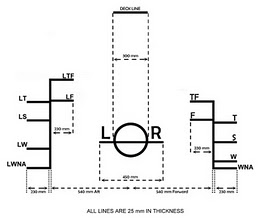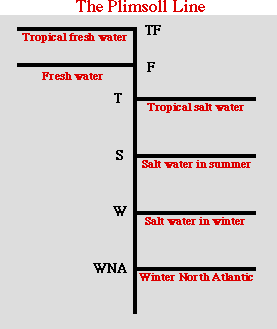There is a link.
In the 1860s, there were a lot of cargo ships sinking due to overloading. The large number of insurance claims which followed led to British MP, Samuel Plimsoll, coming up with the national Load Line or Plimsoll Line.
The Plimsoll Line, which is put amidships, shows the draft of the ship and the legal limit to which it can be loaded for specific water types and temperatures. The letters refer to various waters. The L and R refers to ships registered with Lloyds.

Temperature affects the level because warm water provides less buoyancy, being less dense than cold water. The salinity of the water also affects the level, fresh water being less dense than salty seawater. So the load the ship can carry safely depends where the ship is operating.

Then followed the Plimsoll Shoe which: “…because the coloured horizontal band joining the upper to the sole resembled the Plimsoll line on a ship’s hull, or because, just like the Plimsoll line on a ship, if water got above the line of the rubber sole, the wearer would get wet.”

Which brings us to the definition of seawater:
The world’s peak ocean science body has adopted a new definition of seawater developed by Australian, German and US scientists to make climate projections more accurate.
The science case for a change in the definition of seawater was first agreed to in 2006 when the international guiding body, the Scientific Committee on Oceans Research (SCOR) established a working group, chaired by Dr Trevor McDougall, of CSIRO’s Wealth from Oceans Flagship.


15th December 2011 at 12:37 pm
Olivia,
Thanks. It was put together by someone at CSIRO using WordPress templates etc. The banner was done using Photoshop.
Cheers,
Huw.
15th December 2011 at 12:33 pm
I really like your blog. Very nice colors and choice of theme. Did you make this blog yourself or did you hire someone to do it for you? Plz reply as I am looking to create my own blog and would like to know where youu got this from. many thanks!